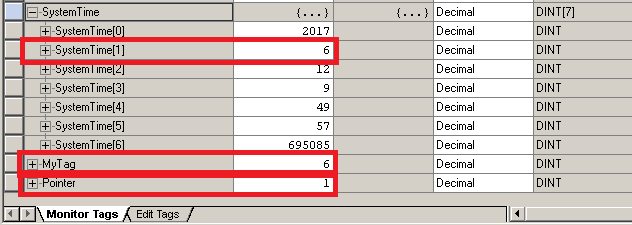

These are going to be replaced with either rack or some sort of remote I/O.
#RSLOGIX 5000 ADDRESSING DOWNLOAD#
These are really the only errors that I have left in the program before I download it and start troubleshooting all of the other stuff that might not work.
#RSLOGIX 5000 ADDRESSING HOW TO#
I'm lost as to how to program the control word that it's looking at. This instruction is looking at R6:0.POS and during the conversion, Studio 5000 did not it. In the same program in routine REC_EDIT, starting at rung 53, they used an Equal instruction that compares the same files you mentioned in your last post. These BTR and BTW instructions aren't writing to another plc so, I didn't see anything else to select.Ģ. The only thing I could see to select in the configuration browse was the local processor. In the Studio 5000 program, it gave me an error saying "No Path Identified".

In that PLC5 program, In the An_Inputs routine, there are a few BTR and BTW instructions. I have about two more things that is giving me a problem in the PLC5 conversion to Compact Logix.ġ. You may want to have your client change their passwords. But to be safe, I would make my arrays 20 x 470. The destination files are 470 INTs long, and the program *seems* to only access 200 INTs (which is why I suggested the 20 x 200 array). If you create an array of 20 x 200 (ranging from 0 to 19, and 0 to 199), then you will have to modify your program to index these numbers and not the 111 - 130 that the program is expecting.Īlso, N50, N51, and N52 are 570 INTs long. Also, see if they will let you put some trap logic in to track what is stored in N49:21 (and any other register of interest).īut it really shouldn't matter since we can be pretty certain where the recipe files are (and how many of them that there is). See if you can get your client to load a recipe, allow you to save the program, and then load a different one. The bottom line is that you will probably need to create an array of arrays (20 x 200) so that you can index through these indirectly in a way that will work for the Logix5k. Probably even more, but all I have to go on is what your PC5 file had for a data snapshot. That's not to say that the other N files in the N111 to N130 range aren't being used, there is definitely some cross-pollination going on between N115, N117, N118, N129, and N130. So we can see that N50, N52, and N127 are linked together. This is what I got:Ĭ:\Users\zzp93j\Desktop\Test Area\17222102 GLATT ROOM 75 VALVE SEQUENCE 11192013.PC5 (3 hits) I pasted that in the search box and asked Notepad++ to find all occurances of this string of data in the program. PC5 file), I copied the data associated with words N50:20 to N50:29. I already knew that files N50, N51, and N52 were associated with the recipe routines, so looking in file N50 (line 638 in your. It's a pretty safe bet that these are your recipe files, and therefore what you will need to re-create them Logix5K style (a two dimensional array, 20 x 200 would work). Looking at your data tables in the PLC5, I see that you have "N" files of 470 integers ranging from file N111 to N130 (inclusive). There is apparently more than one recipe, and based on the 110 added to N49:7, it would make any valid recipe file number greater than 110. Your N49:21 points to the file that contains your current recipe, and it is 200 INTs long ( !!!see note at the end of this post for details!!! ).

I'm not sure where you got 149_21 (N149:21 in PLC5-speak), it should be N, but since it isn't going to work anyway, it doesn't matter.


 0 kommentar(er)
0 kommentar(er)
